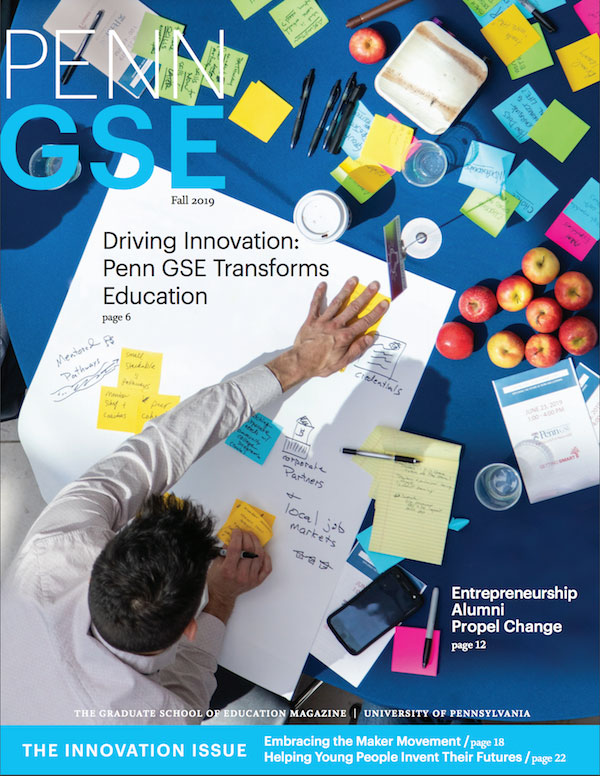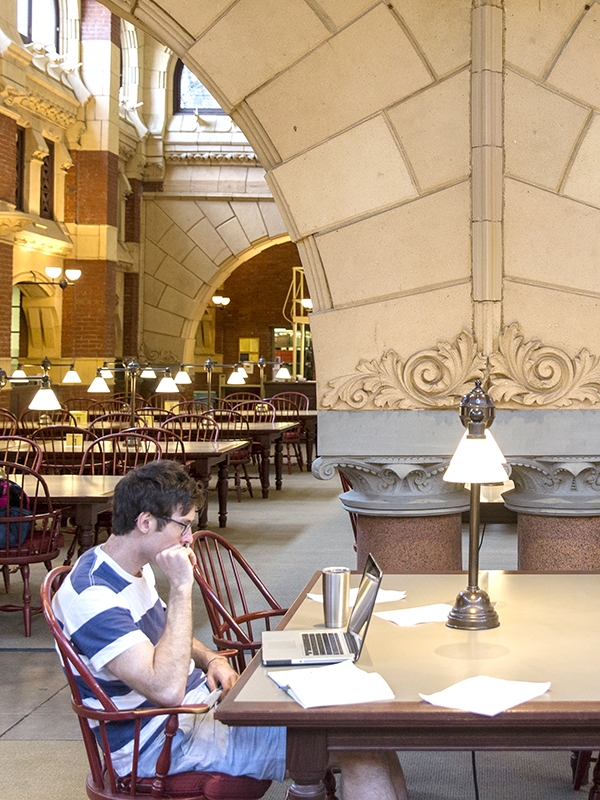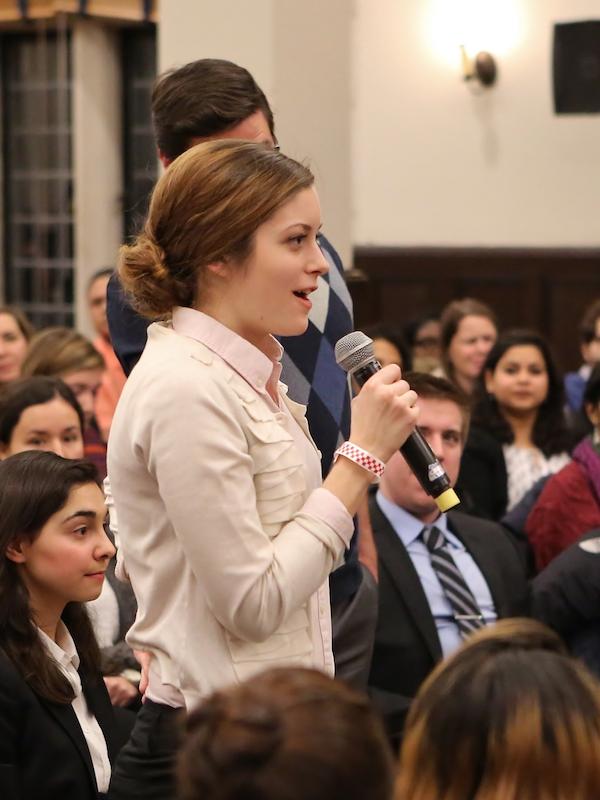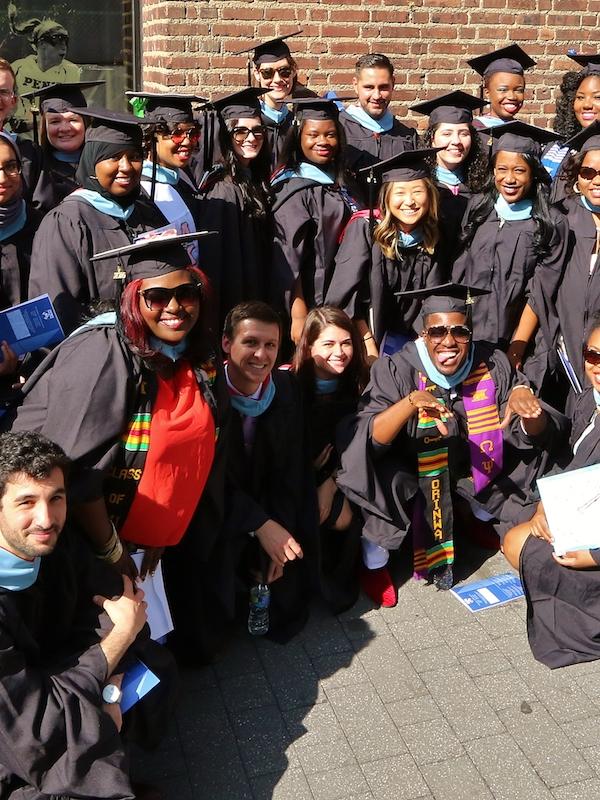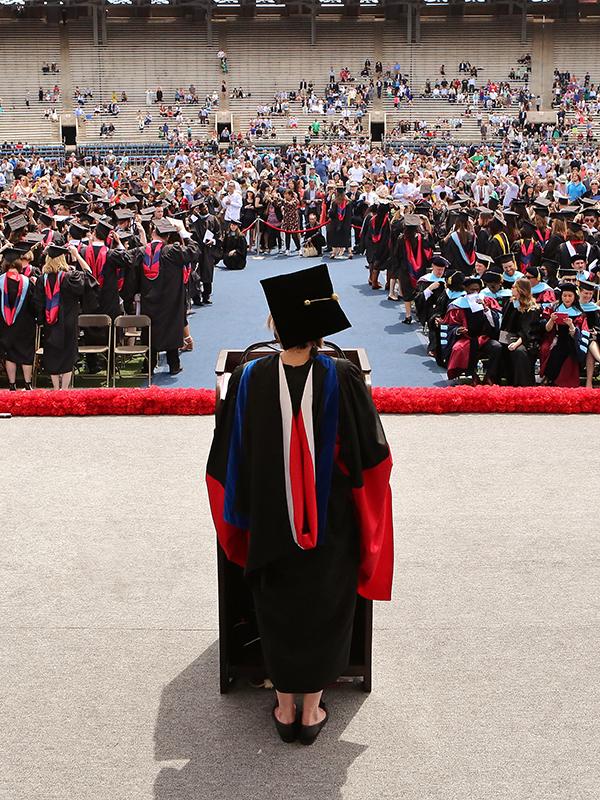Making Memorable Learning: Penn GSE Urban Teaching Residency Students Embrace the Maker Movement
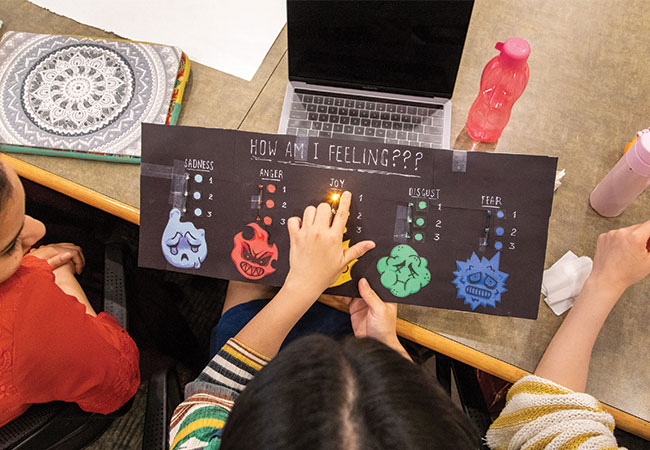
Dr. Kafai’s Maker Studio class prepared two Urban Teaching Residency master’s students for their mission to enhance the makerspace at Christina Seix Academy. Photo by Jay Gorodetzer Photography
by Karen Brooks
When Jenna Brower heard her middle school students at Christina Seix Academy grumbling that the campus playground catered only to younger students, she saw a timely learning opportunity. Having recently introduced an innovation laboratory at the independent school, which enrolls underserved three-year-olds through eighth graders in Trenton, New Jersey, she challenged her students to take action and use the innovation lab to design a playground that would appeal to adolescents.
“I wanted them to use their imaginations to solve a problem that was relevant to their lives. They were amazingly intentional with their plans and thought about everything: cost, safety, accessibility for people with disabilities,” says Brower, who helped the group draft a formal proposal to submit to the head of school. “A big point of the lab is to make students feel heard and to show them that they can be agents for change, whether it’s in their school, in their community, or around the world.”
Now enrolled in the Urban Teaching Residency master’s program at Penn GSE, Brower continues to teach at the academy and recently partnered with colleague and classmate Adrinne St. Fleur to overhaul the burgeoning innovation lab. The effort served as their final project for Maker Studio, a course developed by Yasmin Kafai, the Lori and Michael Milken President’s Distinguished Professor at Penn GSE.
Dr. Kafai launched Maker Studio four years ago to foster technical skills and creativity among Penn GSE students. The course is a nod to the maker movement, a cultural phenomenon that promotes discovery through active brainstorming and building as opposed to passive consumption of information. Educational “makerspaces” such as the innovation lab at Christina Seix have been cropping up in academic institutions worldwide, giving learners communal spaces where they can carry out do-it-yourself experimentation with resources like craft and hardware supplies, computers and tablets, robotics, fabrication equipment, and multimedia tools. To increase Penn GSE students’ exposure to these learning environments, a makerspace is included in the School’s planned building expansion.
“There is an important difference between reading or listening and having a hands-on learning experience. This movement is about returning to experiential learning, bringing back a DIY component that many people feel has gone out the door with all of the emphasis on test scores today,” explains Kafai, who designed the course with technology top of mind. By the end of the semester, her students have constructed electronic circuits using copper tape, LED lights, and batteries; designed and fabricated small objects using a 3D printer; and coded their own video games using basic programming language.
Makerspaces give students an invaluable sense of purpose and allow them to shine in ways that are not possible while seated at a desk.
Assignments like these prepared Brower and St. Fleur for their mission to enhance the makerspace at Christina Seix. Although Brower conceptualized the innovation lab more than two years ago, she was teaching full time and didn’t have the capacity to manage it singlehandedly or to orient other teachers to the facility—and since she primarily worked with older children, she struggled to identify ways to engage the school’s youngest students.
That’s where St. Fleur, lead educator for the school’s three-year-old preschoolers and Brower’s classmate in the Urban Teaching Residency master’s program, came in.
“Before Maker Studio, I had never heard of a makerspace. And before Jenna asked me to help make the innovation lab more accessible to kids of all ages, I didn’t even know it existed,” St. Fleur recalls. After completing the physical task of organizing and labeling materials into cohesive stations that ranged from simple (general art supplies) to complex (3D modeling and printing devices), they switched their focus to devising curricula that incorporated toddlers to teenagers. They wanted to establish pre-K activities that could be extended all the way through middle school.
“I do something called graphics practice, where the three-year-olds draw on dry-erase boards, and it seemed like a good place to start,” says St. Fleur.
She brought the graphics practice activity into the innovation lab by incorporating a robotics element. Her students drew mazes that were then navigated by pocket-sized robots called Ozobots, which are programmed to read lines as pathways they should follow. Brower then built on the activity with her older students, who used Dash Robots—larger robots that respond to a drag-and-drop command system—to solve oversized versions of the preschoolers’ mazes.
“The younger kids were watching the robots go through their mazes and getting a visual idea of what coding can do. The older kids were actually doing the coding, telling the robot where to go and how to solve a bigger maze that was similar to what the younger kids drew,” Brower says. “This allowed the students to learn through play and to bring their creations to life while developing some simple coding skills.”
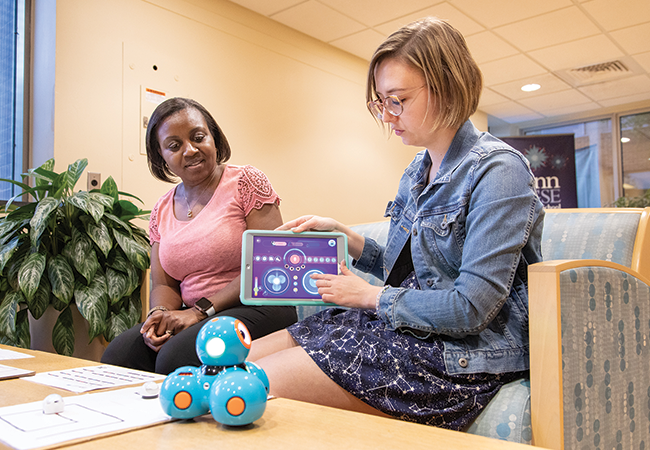
Today, collaboration, communication, computer literacy, and independent thinking are considered twenty-first-century skills essential to success in high school, college, and beyond. Honing such skills in a traditional classroom can be challenging, while makerspaces—where students tinker alongside their peers without explicit instructions from a teacher—lend themselves to enhancing these competencies organically. Both Brower and St. Fleur, who plan to graduate in May 2020 with master’s degrees, credit the Urban Teaching Residency program with illuminating the crucial need for these resources in schools where social and economic problems abound. With an executive-style format designed to fit the schedules of full-time educators, the program explores issues relevant to schools in high-needs areas, including access, poverty, and policy.
“This program has exposed me to a lot of the realities in different communities and schools,” St. Fleur says. “Some teachers don’t have the supplies they need to do their jobs—not even textbooks. We want all kids to have access to technology and creative outlets starting at a young age so they are prepared when they get to high school.”
Makerspaces give students an invaluable sense of purpose and allow them to shine in ways that are not possible while seated at a desk, Brower adds. “Having these spaces in urban environments is important because they provide a more relaxed environment that gives students more agency, allows them to see their full potential, and introduces them to technology they might not have access to anywhere else. They can do anything in the space as long as they are innovating.”
Rob Connor, GR’11, Christina Seix Academy’s founding head of school, credits the innovation lab with students’ success in collaborative problem-solving tournaments hosted by Destination Imagination. A group from the school finished first place in last year’s statewide competition and qualified for the global finals for the past two years.
“This is a wonderfully eclectic group of kids who are thoughtful, contemplative, and diligent about their work, but are not always the most outspoken students,” says Connor. “The innovation lab provides a space for them to find themselves. When engaged in real problem-solving work and open-ended projects, they come out of their shells and find their voices. It’s amazing to see.”
Brower and St. Fleur presented their final Maker Studio project in spring of 2019, but that doesn’t mean their work to improve the school’s innovation lab is done. They expect the space to evolve continually as new tools become available and new lesson ideas emerge. The next station they aim to introduce will center on video production, giving students an opportunity to film and edit their own news and talk shows. They are also diligently spreading the word about the lab to their educator colleagues, inviting them to bring their classes into the space.
“The most compelling part of all this is that Jenna and Adrinne are from a school that had a makerspace, and most of the teachers didn’t even know about it. This illustrates a challenge that many makerspaces in schools face,” Kafai says. “You can put all the tools and materials there, but how do you make it work to the fullest? They have created a meaningful resource, not just for students but also for teachers who might not know much about makerspaces and technology but will learn as they become part of the community that creates activities within their lab.”
This article originally appeared in the Fall 2019 issue of The Penn GSE Magazine.

